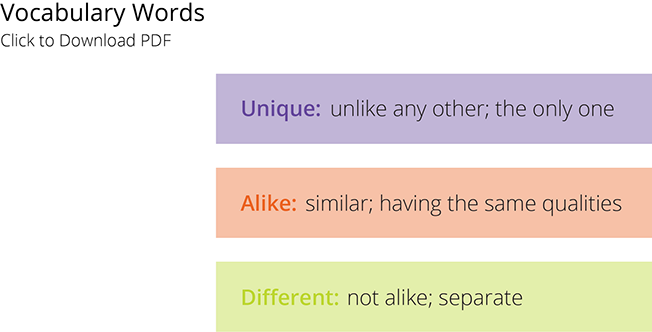S.P.I.D.E.R.S. Program
Safety Playbook for Individual Development
and Engagement of Responsible Students
Elementary Lesson Plan 1: I am Unique
Grade Level: Kindergarten
Objective: Students will define the terms "unique," "alike," and
"different," and list qualities that make them unique.
Lesson Plan
Suggested total instruction time: 15 - 25 minutes
Introductory Activity
You will begin the activity by providing students with a Snowflake Cutout that they can color and decorate however they wish. Once they have completed decorating their individual snowflakes, instruct each student to bring his or her snowflake to the front of the room and attach it to the board, around the Snowman Visual resource.
1. Class Discussion
When all students have added their snowflakes to the front of the room, direct their attention to the snowman. Ask the students, “What do you notice about these snowflakes?” Point out some of the characteristics of a few of the snowflakes. Maybe one is all blue, and maybe another has all of the colors of the rainbow. Noting these differences will help transition into making the point that all students are different, too.
It is important that students understand the terms on the vocabulary list, which can be accessed by clicking the Vocabulary Words sheet. Introduce, explain, and ask the students for examples of each one. As you transition from talking about the snowflakes to characteristics that make us unique, the following are examples of points to make:
- Differences are a good thing, and you should be happy that you’re different.
- Being unique is what makes individuals special and important.
- Consider ways that you and your neighbor are alike and how you are different.
- Think about what the world would be like if no one was unique.
2. Mid-Class Activity
Instruct students to form groups of 3 or 4 (depending on class size) and find a station along the wall, indicated by a construction paper sign. Once each group is positioned in a different starting station, explain that if the item on construction paper applies to anyone, that student is to put their name on the paper. Give each group about one minute before rotating to the next station. At each station, some students will be putting their name on the poster while others won’t, prompting conversation about similarities and differences between classmates.
Once all students have moved through each of the stations, instruct them to return to their seats and quickly debrief on the activity, asking students questions to help them realize that each of them is unique. These questions can include:
- Did everyone write their name on every piece of paper?
- How many pieces of paper did you write your name on?
- Why do you think different students wrote their names on different pieces of paper?
- If no one was unique, would this activity have a different outcome?
- What would be different?
3. Optional Use of Additional Resources
This is where the resource text could be shown to the class, via the YouTube recording of the text being read. This video is two minutes long and can be used to generate additional conversation if needed. Click on the It's Okay to Be Different image to the left to access the resource.
Please do not use any optional resources without completely reviewing them first.
4. Partner Activity to Assess Students
Instruct students to partner with the classmate sitting next to them, and prompt the class to discuss the questions that you've prepared. Both students are to exchange responses, as you walk around to listen and facilitate the conversation.
Example questions include the following:
- “What did you learn about yourself and your neighbor?”
- “What makes you special?”
- “What makes your neighbor special?”
- “What did you learn today?”
The assessment will be informal to gauge student understanding of the material. Your goal is to have a good grasp, from listening to students engaged in conversation with their partners, on whether or not each student has a firm or weak understanding of the material.
5. It's Okay to Talk About It
At the end of the class period, talk to students about the importance of communicating with a parent or guardian about any issues that he or she might be facing. It's important to encourage students to discuss situations that might make them feel uncomfortable, right away. Help them to understand that asking for help is nothing to be ashamed of, and that knowing when to ask for help is a sign of strength, not weakness.
Spider Learning, Inc.
2652 Hidden Valley Road
Upper St. Clair, PA 15241
412.444.8346
www.spiderlearning.com
Copyright 2018 | Spider Learning, Inc.


